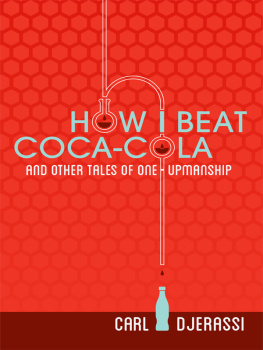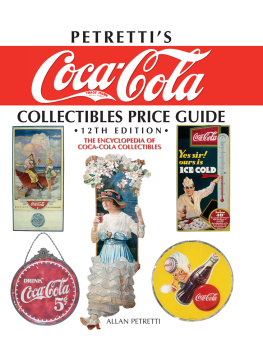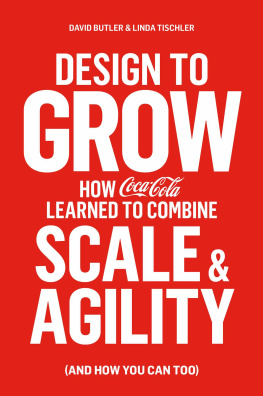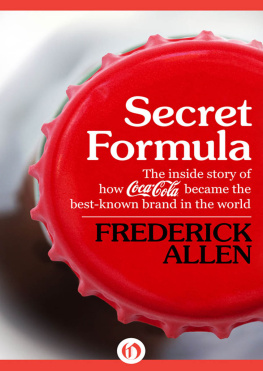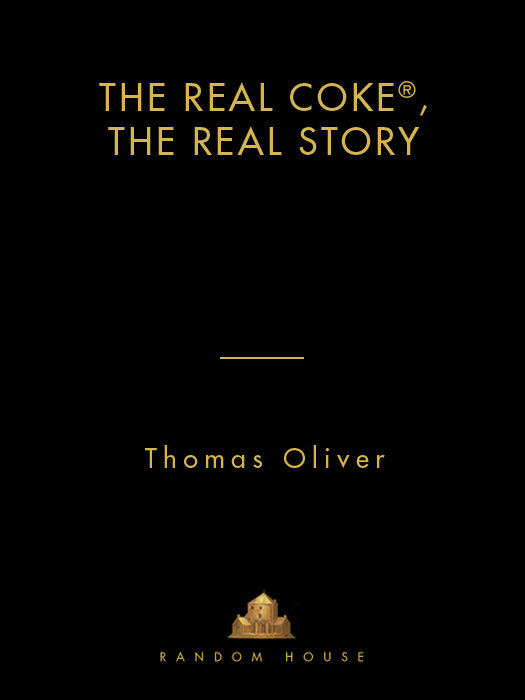Copyright 1986 by Thomas Oliver
All rights reserved under International and Pan-American Copyright Conventions. Published in the United States by Random House, Inc., New York, and simultaneously in Canada by Random House of Canada Limited, Toronto.
Coke is a registered trademark of the Coca-Cola Company.
This book has been neither authorized nor endorsed by the Coca-Cola Company.
Library of Congress Cataloging-in-Publication Data
Oliver, Thomas, 1950
The real Coke, the real story.
1. Coca-Cola Company. 2. Soft drink industryUnited States. 3. Coca-Cola CompanyHistory. 4. Soft drink industryUnited StatesHistory. I. Title.
HD9349.S634C67 1986 338.7663620973 8610151
eISBN: 978-0-8041-5131-3
v3.1_r1
CONTENTS
PROLOGUE
On April 23, 1985, the top executives of the Coca-Cola Company held a press conference in New York City. News had leaked out that Coke, the king of soft drinks, would no longer be produced. In its place the Coca-Cola Company would offer a new drink with a new taste and would dare to call it by the old name, Coca-Cola. At the Vivian Beaumont Theater in Lincoln Center, some two hundred reporters, photographers, and cameramen eagerly awaited confirmation of the sensational news, while hundreds more participated via satellite hookup in Los Angeles, Chicago, Houston, Atlanta, and Toronto.
Why, after all, was there so much interest? Because Coke is more than just a soft drink. What the famous Kansas newspaper editor William Allen White wrote is true: Coca-Cola is the sublimated essence of all that America stands for. A decent thing, honestly made, [and] universally distributed.
Coke had grown up with twentieth-century America, where rites of passage are marked by moving from sipping Coke as a soda pop to mixing it with rum as an adults elixir. And that famous Coca-Cola logo appears on signs and billboards in virtually every other country as well, linking America to the rest of the world and looming as large as a symbol of the United States as the Statue of Liberty. Coke is so strongly identified with the United States that when countries fall out with us politically, Cokes exile sometimes closely follows the expulsion of our ambassador. Antiwestern insurgents often identify Coca-Cola as the most visible example of capitalism in their countries and have blown up or taken over more than one Coca-Cola bottling plant in retaliation for some alleged grievance.
At home, Coke is more than a drink: it is sandlot baseball, high school pep rallies, that first drivers license, hot rods, swimming pools, and street dances. It is the pause that refreshes and reminds us all of the good times, and it has even helped us through some of the bad.
With that passionate public concern in the background, amid the television lights and the red wash of Coca-Cola banners, on that April day in 1985, Roberto C. Goizueta, the chairman and chief executive officer of Coca-Cola, announced that the best has been made even better. The worlds largest soft-drink company had developed an improved taste for the worlds number-one soft drink. After one hundred years, Coke would have a new taste.
Goizueta said that his companys decision to make the change was based on nearly two hundred thousand consumer taste tests, which had revealed a resounding preference for the new flavor. To market research experts, to our bottlers, and to the retail trade, these numbers represent a staggering superiority, declared Donald R. Keough, the president of Coca-Cola. In no uncertain terms Goizueta told the press that the bold change was backed by tremendous confidence and enthusiasm on the part of the Coca-Cola Company. It was the surest move the company ever made, he said.
And so the new Coke was launchedand the reaction of the American people was immediate and violent: three months of unrelenting protest against the loss of Coke. So fierce was the reaction across the country that it forced a response from the Coca-Cola Company. On July 11, 1985, Goizueta and Keough called another press conference. This one took place at the companys headquarters in Atlanta, and this time there was no hoopla, no dog-and-pony show, no bragging and arroganceonly unadorned humility. Stunned Coca-Cola executives stepped up to the microphone and publicly apologized to the American people. They announced that the company would reissue the original Coca-Cola formula under a new name, Coke Classic.
Never before had a major corporation told the American people that it was sorry, never before had a corporate giant begged consumers for forgivenessand never was an apology so quickly accepted.
But how could the company that owns the worlds most famous trademark have been so wrong about its significance? How was a $7 billion corporation, which produces not just Coke but diet Coke, Tab, Sprite, Minute Maid orange juice, and movie hits like Ghostbusters, brought to its knees by consumers? Could Coca-Colas management team, with its sterling track record, really have been so blind that it didnt foresee the fiasco? Or was the whole event a huge publicity stunt, a carefully calculated plot to launch a new cola and boost the sales of the old one?
The Real Coke, The Real Story is a behind-the-scenes account of how and why the company changed the taste of its flagship brand. Much of the story has never been told before. It involves the life of the Coca-Cola Company itself, from its early boom years, through a period of benign neglect and increasing losses to its major competitor, to the resurrection of the company under a new management in 1980. The Coca-Cola Company of the early 1980s was one of the most admired business organizations in the United States, according to a Fortune magazine poll of eight thousand business executives and analysts. It purchased Columbia Pictures Industries, formed Tri-Star Pictures, introduced diet Coke and cherry Coke, all the while increasing shareholders return on investment by 22 percent. It seemed the management of Coca-Cola could do no wrongjust a moment before it made what appeared to be one of the major blunders in the chronicle of American business.
The result of that mistake is another part of the storythe remarkable reaction of those who refused to accept the axiom that the consumer is powerless in the face of a corporate giant and who persuaded Coca-Cola to bring back Americas old friend.
CHAPTER 1
THEY DONT MAKE COKE ANYMORE
The Coca-Cola Companys news of April 23, 1985, sent shock waves across America. The unique taste of Coke would soon be a thing of the past, no more than a memory evoking a different era, a different way of life. Some people cried, some scoffed, some wrote scathing articles, and others frantically set about to stockpile enormous hoards of their irreplaceable longtime favorite. But everywhere Cokes large and loyal following asked, Why did they do this to Coke?
Dan Lauck, a reporter on KHLO-TV in San Antonio, Texas, drinks little else but Cokeno beer, no coffee, no tea or milk. Although he may have a mixed drink three or four times a year, he never mixes Coke with alcoholWhy ruin a good Coke? he asks. The thirty-five-year-old insists on drinking only Coke that comes in the original six-and-a-half-ounce bottle, and his habit, which has gone on since his college years, is to consume twelve of these bottles a day. If he plays tennis in the hot Texas sun, he may drink a whole case in a single day. To compensate for his immense caloric intake from Coke, Dan has had to forgo both breakfast and lunch.


